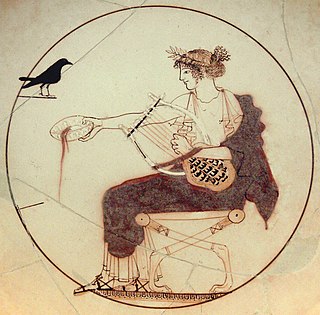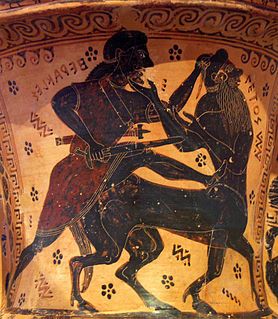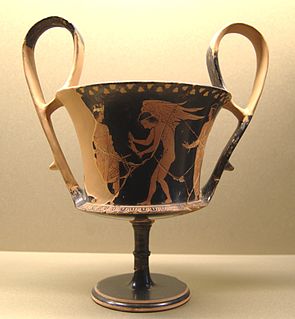

The Pistoxenos Painter was an important ancient Greek vase painter of the Classical period. He was active in Athens between c. 480 and 460 BC. Many vases have been attributed to his hand on the basis of style.

Ancient Greece was a civilization belonging to a period of Greek history from the Greek Dark Ages of the 12th–9th centuries BC to the end of antiquity. Immediately following this period was the beginning of the Early Middle Ages and the Byzantine era. Roughly three centuries after the Late Bronze Age collapse of Mycenaean Greece, Greek urban poleis began to form in the 8th century BC, ushering in the Archaic period and colonization of the Mediterranean Basin. This was followed by the period of Classical Greece, an era that began with the Greco-Persian Wars, lasting from the 5th to 4th centuries BC. Due to the conquests by Alexander the Great of Macedon, Hellenistic civilization flourished from Central Asia to the western end of the Mediterranean Sea. The Hellenistic period came to an end with the conquests and annexations of the eastern Mediterranean world by the Roman Republic, which established the Roman province of Macedonia in Roman Greece, and later the province of Achaea during the Roman Empire.

Athens is the capital and largest city of Greece. Athens dominates the Attica region and is one of the world's oldest cities, with its recorded history spanning over 3,400 years and its earliest human presence starting somewhere between the 11th and 7th millennium BC.
John Beazley gave him the name from a skyphos now at Schwerin with a signature indicating that it was made by the potter Pistoxenos. [1] It depicts Iphikles being taught music by Linos, and Heracles accompanied by his tattooed Thracian servant Geropso.

Sir John Davidson Beazley, was a British classical archaeologist and art historian, known for his classification of Attic vases by artistic style. He was Professor of Classical Archaeology and Art at the University of Oxford from 1925 to 1956.
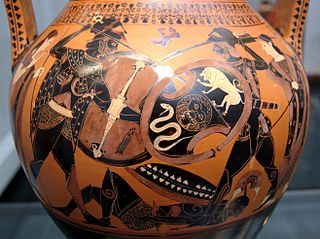
In classical archaeology, a name vase is a specific "vase" whose painter's name is unknown but whose workshop style has been identified. The painter is conventionally named after the selected "name vase" that embodies his characteristic style, or for one of its distinctive painted subjects, or for other attributes.
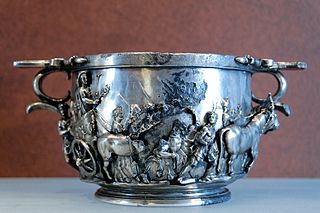
A skyphos is a two-handled deep wine-cup on a low flanged base or none. The handles may be horizontal ear-shaped thumbholds that project from the rim, or they may be loop handles at the rim or that stand away from the lower part of the body. Skyphoi of the type called glaux (owl) have one horizontal and one vertical thumbhold handle.
The Pistoxenos Painter probably started his apprenticeship under the Antiphon Painter in the workshop of Euphronios. He specialized in kylikes , which he painted in the red-figure style, bringing "the delicacy of Late Archaic vase-painting into the Early Classical style". [1] Some of his best pieces, however, were produced in the White Ground Technique. The most important motifs of his paintings are horses, warriors and thiasos imagery.

The Antiphon painter was an Athenian vase painter of the early 5th century BC. He owes his name to a double Kalos inscription of Antiphon on the dinos stand in the Antique collection of Berlin. He was active between 500 and 475 BC in Athens as a painter of the red-figure style in the largest workshop of the 5th century. He learned his handicraft in the workshop of Euphronios and Onesimos. There he worked closely with them, the Kalmarer painter and other painters.

Euphronios was an ancient Greek vase painter and potter, active in Athens in the late 6th and early 5th centuries BC. As part of the so-called "Pioneer Group,", Euphronios was one of the most important artists of the red-figure technique. His works place him at the transition from Late Archaic to Early Classical art, and he is one of the first known artists in history to have signed his work.

Red-figure vase painting is one of the most important styles of figural Greek vase painting.
He was one of the first painters to employ four-colour polychromy, using slip, paints and gilding. This style often resembles monumental painting. In his later works he grew so skillful that he could omit the "relief line". Stylistically, he is close to the Penthesilea Painter. His kalos inscriptions refer to the names Lysis, Glaukon and Megakles.

A slip is a liquid mixture or slurry of clay and/or other materials suspended in water. It has many uses in the production of pottery, and other ceramic wares.

The Penthesilea Painter was a Greek vase painter of the Attic red-figure style. His true name is unknown. His conventional name is derived from his name vase, "bowl 2688" in Munich, the inside of which depicts the slaying of Penthesilea by Achilles. On the basis of that work, John Beazley attributed 177 known vases to the painter, about 100 of which only survive fragmentarily. Bowls, 149 in number, represent the bulk of his work. The rest is distributed among small shapes like skyphoi, kantharoi and bobbins.
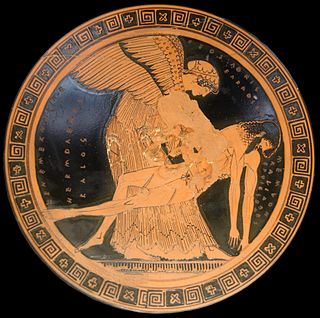
A kalos inscription (καλός) is a form of epigraph found on Attic vases and graffiti in antiquity, mainly during the Classical period from 550 to 450 BC. The word kalos (καλός) means "beautiful", and in the inscriptions it had an erotic connotation.




